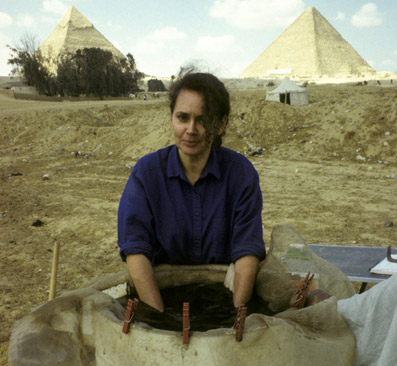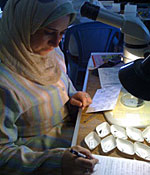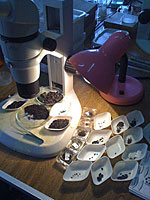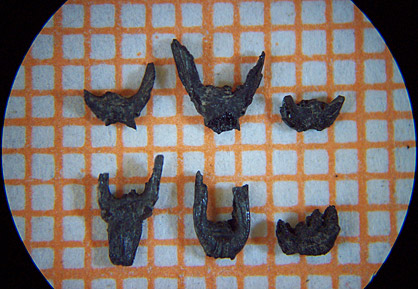Posted by Mary Anne Murray
A bucket of water and a bag of dirt…an inauspicious start to a journey of discovery.
This journey is an ancient botanical one and the beauty of the thing is that plants float – the key to their recovery. Indeed, the process is known as flotation and it is how we find the many plant species from our two town sites of Heit el-Ghurab (HeG) and Khentkawes Town (KKT).
Plant remains (seeds, fruits, nuts, etc) are taken from the diverse living areas within these towns – hearths, ovens, floors, pits, alleys, storage jars, silos, rubbish dumps and so on – and can reveal vital details about food, as well as agriculture – one of the most important aspects of daily life for most ancient Egyptians.

Mary Anne doing flotation to recover plants at Heit el-Ghurab (photo by Mark Lehner)
The ancient plant remains from both towns are all preserved by charring, i.e. they were burnt, for a variety of reasons, and were therefore preserved. They were originally brought into these settlements as food, fuel, animal fodder (and later in animal dung used as fuel), medicines, dyes, bedding, matting, textiles, tools, basketry, building materials, temper for pottery, plaster and mud brick, and so on.
The discipline itself is called archaeobotany – the study of ancient plants. But why bother to study these small, burnt, discarded items from such big impressive sites anyway?

Archaeobotany Field School student Rabab el-Gandy sorting and identifying plants from KKT (photo by Mary Anne Murray)
Well, because it’s fascinating actually and can provide important clues to some of the most elemental questions about an ancient settlement. What foods they were eating (or not eating)? What changes took place in their diet through time? Does their diet reflect differences within a ‘town’ site, such as relative status? Were the residents farmers themselves or was their food procured or even provisioned from elsewhere? Were some foods imported or traded? How do the plants from comparable sites (e.g. temporally, regionally, etc.) compare with each other?

The processes of sorting ancient plants into different species and other categories. (photo by Mary Anne Murray)
For example – bread and beer – were the staple foods for the town’s residents and indeed, most if not all ancient Egyptians. These were made using the cereals emmer wheat and hulled barley. Emmer wheat (not commonly used in Egypt since Greco-Roman times) was primarily for bread but also used for beer, while barley was most suitable for the later. Their diet also included lentils and other legumes, as well as fruits such as figs and grapes. There is also Linum – important for its oil (linseed) and its fiber to make cloth (flax). Their fuels were primarily the wood of Nile acacia and the ‘wastes’ from processing emmer wheat and barley (chaff, straw and lots of weeds). Animal dung was also handy to fuel cooking and heating fires.

Emmer wheat chaff (photo by Claire Malleson)
With attention primarily focused on the spectacular monuments and treasures from the temples and tombs of ancient Egypt – the minutiae of everyday life discovered in the charred debris of an Egyptian town – brings to life the details of their daily bread and a unique agricultural tradition, which, village by village all along the Nile, formed the strong backbone of the ancient Egyptian state – what’s not to like?
Archaeobotany – an essential piece of the puzzle of any ancient settlement.
Mary Anne Murray
